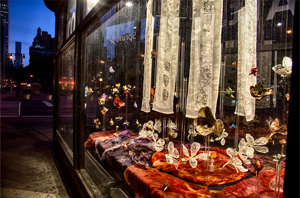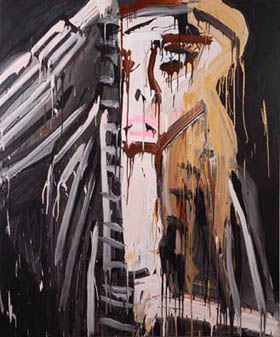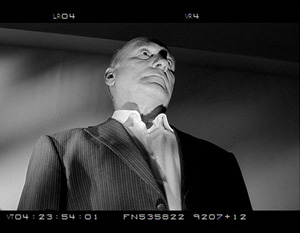Consuming Culture
John Haberin New York City
Dennis Congdon and Katherine Bernhardt
Daniel Canogar and Serena Gidwani Buschi
Tired of the trash piling up in galleries? Disturbed at the post-industrial waste piling up in America and the Third World, in an age of globalization? Why not make it into art?
For Dennis Congdon and Katherine Bernhardt, it speaks not just to western civ, but to their personal hoarding as well. Daniel Canogar has a greater tech savvy when it comes to sculpture. He finds new uses for used electronics, and he reinvents their own.  Even a geek, though, should acknowledge that something deeper runs through them than market forces. Serena Gidwani Buschi makes the laws of physics and biology into art, and she accepts your own DNA. And they pulse with life as much as trees in the park across the street.
Even a geek, though, should acknowledge that something deeper runs through them than market forces. Serena Gidwani Buschi makes the laws of physics and biology into art, and she accepts your own DNA. And they pulse with life as much as trees in the park across the street.
Western civ
Truly worried about trash piling up everywhere? Artists are only getting started. Dionisio Gonzáles and Mary Mattingly have brought the impact home in photographs. Some might even call it an installation. Yet why not put it on canvas? It makes much less of a mess that way, and it can seem like fun.
Dennis Congdon and Katherine Bernhardt do, and they take the trash personally, like the hoarders elsewhere in "The Keeper." What to others is junk is for them a matter of everyday life. Congdon could see it outside his window, during a stint in the early 1980s at the American Academy in Rome, but his paintings do take liberties. One huge pile contains ruined statues and antique columns. Another appears to have pillaged museums for Modernism from Pablo Picasso to abstraction. The references to architecture, Cubism, and all-over painting are not an accident, not when shapes and colors get to slide every which way. Yet they are not the whole story.
They do not obliterate the ground or the air, but they do leave one guessing. Pink or lavender might just as well stand for a human arm as a sculpted one—or for a loaf of bread. This is western civilization as product for human consumption, in a color scheme that the gallery compares to Lucky Charms. Philip Guston and comic strips paved the way, but so did Julian Schnabel with smashed plates and Sandro Chia or Francesco Clemente with lighter shades. Like Chia, Congdon relies as much on curved lines as fields of color, most often broken into short strokes. Civilization may be about to come to a screeching halt, but a battered head on its side can still manage a smile or a nap.
When it wakes up, the waste will have piled higher, but no one here seems likely to stop consuming. Neither does Bernhardt, whose paintings attest to an unhealthy but rewarding lifestyle. One composition has the charming combination of sliced watermelon and telephones, another burgers, fries, and basketballs. They add up to a compendium of fast food and consumer electronics—the first on its way to the garbage and the second, like cassette tapes and boom boxes, already there. Here western civilization has a far shorter memory. In fact, it never leaves America.
 Obviously this is not just her history, unless Bernhardt has gained a great deal of weight and taken up basketball. She calls the show "Stupid, Crazy, Ridiculous, Funny Patterns," a title that could apply to quite a few painters out there, including Katherine Bradford at her own gallery. She offers her subjects as temptations for the viewer, with equal parts empathy, enthusiasm, and disgust. In the past she did much the same with women, from their point of view, in a graphic expressionism that turns Picasso's whorehouse or a fashion runway on its head. The progression from women to food and music makes perfect sense, as further appeals to the senses and to desires. So does the assimilation of junk to junk food.
Obviously this is not just her history, unless Bernhardt has gained a great deal of weight and taken up basketball. She calls the show "Stupid, Crazy, Ridiculous, Funny Patterns," a title that could apply to quite a few painters out there, including Katherine Bradford at her own gallery. She offers her subjects as temptations for the viewer, with equal parts empathy, enthusiasm, and disgust. In the past she did much the same with women, from their point of view, in a graphic expressionism that turns Picasso's whorehouse or a fashion runway on its head. The progression from women to food and music makes perfect sense, as further appeals to the senses and to desires. So does the assimilation of junk to junk food.
Something does get lost along the way, only starting with feminism and personal histories. Bernhardt's women from 2008 have a slashing, confrontational style that looks startling even now, and they bring German Expressionism into contemporary America and in your face. The new paintings still let paint drip off the subject matter, and colors still run wild, but never slapping hard against one another and with much less black. The subjects, too, look much tidier, with one kind of junk in the spaces between another. Maybe Bernhardt takes her unserious title a little too seriously. Still, she and Congdon make consuming culture hard to resist.
Data overflow
So whatever is one to do with old electronics? Try giving them to Daniel Canogar. Not that he is asking, but it would keep them from cluttering up a closet—or a dump site. It would keep your contacts and your lifestyle safe from Google, Amazon, Facebook, and a host of advertisers, and it would save you embarrassment. Besides, he would turn them into art. The only drawback is the reminder of how artless and clunky they were all along, when you thought of them as carrying you into the future.
Canogar does not so much repurpose technology as riff on its original purpose. The roller from a used printer rests atop a projection of what it might have printed, if only it had the impulsiveness of an artist rather than a text. Cell phones come back to life as projections onto their cases, while remotes pile up just as at home. Keyboard letters and calculators spill out onto shelves just above elbow height, and then letters and numbers tumble further as shifting points of light. Was something lost along the way? The printer's mechanical bands seem coiled for action while going nowhere fast, and the keyboard, at least in projection, seems to be missing its shift key.
The Spanish artist nurtures motion, so long as it unfolds in light. He treasures personal histories, as discards and disguises. He gives each work the intimacy of a small shelf on the wall, and then its intimate possessions spill over into the space of the gallery. CDs or DVDs recover their silvery surfaces as shifting projections on the ceiling. Back in 2010, his disks held faces, seemingly of those around one, but actually from Alfred Hitchcock and Dial M for Murder. Here the fixation on old narratives remains, but the only mystery is the media.
Canogar has given something up, in the puzzle of layered narratives, although I cannot swear that the layers ever cohered all that closely. He also runs the risks of quick jokes or cheap nostalgia, but so do new media in art. Recently LoVid said good-bye to twenty-five years of the Experimental Television Center, with an entire room of old TVs. In a more working-class borough, Rossella Biscotti creates a film portrait of the mob infiltrator known as Donnie Brasco, from countless hours of interviews, requests under the Freedom of Information Act, and largely censored public records. Yet she cannot help bathing The Undercover Man in clapboards and film countdowns, analog clocks and incandescent light bulbs, the 1977 movie of the case, dark shadows, and film noir. Even Nam June Paik, the inventor of the art form, can be hard to separate from fond memories of broken CRTs and a naked woman playing the cello. 
New media become old, just as Canogar envisions. That can pose an opportunity for art able to question both formalism and memory. Yet it can also pose a problem, now that video has become ubiquitous—and now that consumerism and Hollywood have kept up with slick technologies and artistic challenges. Maybe the medium was never the message after all. Does the gallery or Eyebeam, which helped propel new media past the picture tube that propelled such innovators as Gary Hill and Bill Viola, still have a mission? Bitform's previous show, of Erwin Redl, built perpetual-motion machines from LEDs, but also from such quaint technologies as electric fans and Ping-Pong balls.
Do not give up on any of them. Biscotti's subject attests to a life undercover merely by replying whenever possible with yes or no, before responding quickly and frankly to a follow-up. Redl's or Canogar's explorations can still evoke a smile or a sense of wonder—especially when they juxtapose a medium's time frames and purposes. Canogar's most focused work sticks to a single object, a dated circuit board. Tracks of light illuminate its preposterously large strips of semiconductors, before following their curves onto the narrow shelf. Talk about data overflow.
Signs of life
On a chilly fall evening, the Flatiron Building was pulsing with life. Light was shining from within through silky white embroidery hanging from above, transparent rods beside it, and glass vials with DNA samples on the pedestal floor. Painted flowers hung there, too, at all angles and in many colors, like birds in flight. More flowers spread beneath them, but in translucent fabric on light wire frames rather than in plaster. Air from the vents below lifted a carpeting of light fabric much like saris, in an exotic mix of orange, yellow, purple, and red. The colors rose and fell as if they were breathing.
Maybe I should have said not pulsing with life, but with signs of life. No one can enter the Prow Art Space anyway except on special occasions, through the mobile device store to the south. And the artist, Serena Gidwani Buschi, delights in signs, many of them borrowed from biology and physics. Sculpted flowers and vials suggest an experiment in progress. The embroidery represents particle tracks in an accelerator, Feynman diagrams used to calculate the interaction of light and matter, and a fair number of equations—drawn from special relativity, classical and quantum mechanics, and the laws of electricity and magnetism. As a former physics student, I can safely identify them for you as science's greatest hits.
You may recognize a few yourself. (Yes, they include E = mc2.) If not, no matter, for nothing is riding on them. They do not correspond to anything particular at hand, and they govern what is happening all the same. Buschi calls the installation Flora Sutra: L = T – V, which sounds heavy handed even to me. Just so you know, L compares two forms of energy, the kinetic energy of motion and the potential energy available to do work, and one can plug L into yet another exotic equation to get a remarkably simple alternative to Newton's laws.
That alternative, as it happens, relates to a principle of least action: left to itself, nature explores every possible pathway, but it always hits on the one that keeps variations from the final outcome to a minimum. You can think of things as taking the path of least resistance. As if in agreement, the air from the vents mostly subsided within days after the opening. The pulses had seemed so much a part of the design, but they were a lucky accident all along. By another lovely coincidence, the artist first lay down orange fabric and black embroidery, and then the installation had to take a break for Halloween.
Details aside, the title gets at something. Buschi is bringing together traditions, even if it means invoking equations more as mystic incantations than as science. Asian fabric meets western science and art, not unlike for Hu Bing and Xin Song in the space before her. She is also bringing together perspectives within the west in the present, like Heidi Lanino Bilezikian in the very same space—tactile and visual, art and physics, object and representation. And the colors still look alive, especially after dark. Keep those equations coming.
Just across the street, Giuseppe Penone has his own signs of life. He erected three bronze trees, shorn of leaves, just in time for the seasonal loss of foliage in Madison Square Park. With a patina after white bark rather than bronze, their roughly six tons blend in reasonably well, especially with an actual but incredibly thick dead tree now all but reduced to its trunk. Ideas of Stone also responds pliantly to its surroundings, but to heavy white stones rather than to life. One tree nestles stones in its branches, one seems to have thrust them off the ground, and one bends to earth under their weight. Penone describes them as balancing, lifting, and bending. Art gives nature an assist once again, while cataloguing its processes.

Dennis Congdon ran at Horton and Katherine Bernhardt at Canada, both through March 2, 2014, Daniel Canogar at Bitforms through April 26, Erwin Redl there through March 15, Rossella Biscotti at SculptureCenter through May 12, Serena Gidwani Buschi ran at the Prow Art Space of the Flatiron Building through January 31 curated by Cheryl McGinnis, and Giuseppe Penone in Madison Square Park through February 9.




